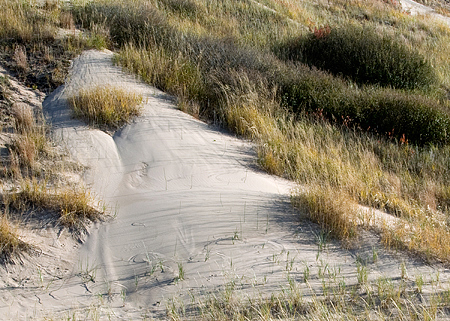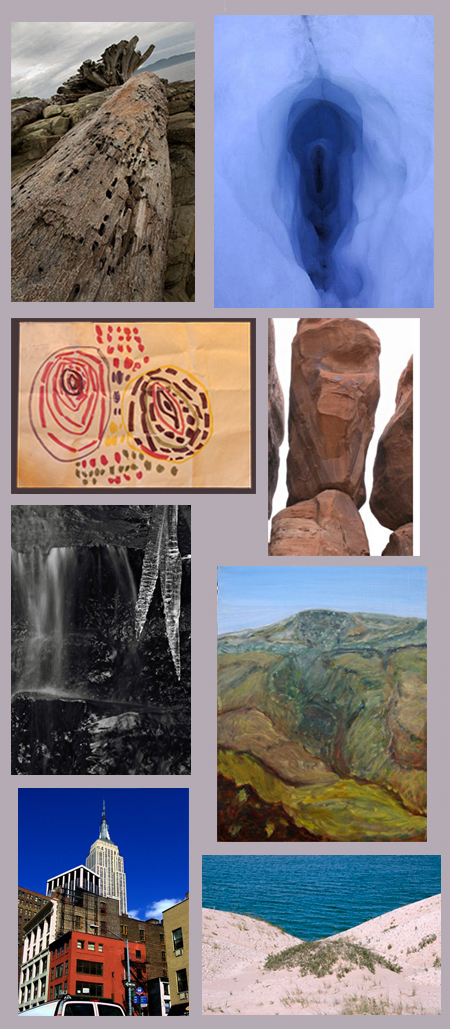Fall Dune

Below is a table with images from A&P and a 20th century painting.

Is there a trend?
a multi-disciplinary dialog
Posted by Birgit Zipser on November 16th, 2007
Fall Dune

Below is a table with images from A&P and a 20th century painting.

Is there a trend?
Filed in photography,sex

Birgit,
Where did that blue one come from? I assume it’s O’Keefe, but at first I thought you must have tinted one of my rock photographs, though I can’t find that I ever showed that one.
And I’m shocked you can contemplate those icicles on any but the highest philosophical plane.
Steve,
Georgia O’Keeffe – Ice Cave – circa 1950.
..icicles on any but the highest philosophical plane.
Are you a believer in the mind-body dichotomy?
Showing this post to my friend Sarah this morning, she exclaimed how beautiful your icicles are.
Steve,
Did I select my data?
Or did I consider your one ‘vulva-ey’ photo tucked away at the end of a post an outlier compared to your 7 phallic-ey pictures (bw and color) on rock posts?
Is there a trend?
Yes, but it’s been going on for at least a few thousand years.
Now that we have established that this trend has been going on for a least a few thousand years, I am inviting thoughts on a possible difference between this innate trend and heterosexual delight in body parts.
Has it really been going on for a few thousand years?
My limited knowledge in art and architecture brings to mind the Washington monument and church towers. I don’t know anything about the innate expression of historical females.
Birgit, I’d have to do some serious digging around to find you links to any specific examples, but a lot of primitive and tribal art from various parts of the world probably qualifies.
David,
That makes sense.
Birgit
It’s really these type of your work having a sexual content very related to your son Karl who has a strong sexual content in his work too. Maybe, as in my own prespective, the human procreational organs (imprinted instints) was passed from mother to son.
Many cultures worship the sexual organs… well its how humans maintain the species evolving, but our racional side is always so afraid of expressing it.
Angela,
Thank you for sharing your thoughts on sexuality.
very related to your son Karl who has a strong sexual content in his work too
Perhaps there is something going on here that we don’t know about.
Arthur I am refering to Karl paintings themes and his mother themes… haven’t you realised?
Birgit,
I am heartened by the fact that you are Karl’s mother. For some reason I have kept thinking on the chances of two people with the same last name collaborating on A&P but never thought of the mother son bond. Great…
I have begun to look at your dune pictures suddenly in a not so innocent way…
The one posted next to Richard Rothstein’s Empire state is the most evocative and most provocative…
What attracts me to the dunes is the changing texture of the sand and color of the water. I also like the geometry, round shapes rather than sharpness.
My recognition of sexual motifs in this landscape the past summer may reflect the spirit of the place. According to an Ojibway Indian Legend, the dune is a mother bear.
I substituted one of the 20th century paintings with one from A&P
Birgit,
The mother-son thing still fascinates me. Did you being a neuroscientist influence Karl in becoming one?
Has the sexual content in your art influenced his art or was it the other way around when it came to art?
Sunil,
My children had no interest in science as they grew up even though they spend much time on the Cold Spring Harbor Laboratory campus. But in junior college Karl did get interested in neuroscience when he did a stint in my lab.
About sexual content: I am still in my art infancy and I have not seen much of Karl in the last decade as he enjoys visiting his grandmother in Germany.
Perhaps this is a case of Panpsychism, that is (and I just learned this) the idea that all things, even objects, have minds. See the NYtimes magazine from Sunday…
If there is a mind in things, than art would have the best shot of being a mind reader, as these photos show.
Article:
http://www.nytimes.com/2007/11/18/magazine/18wwln-lede-t.html?_r=1&ex=1353128400&en=cb64fd802346b7d5&ei=5088&partner=rssnyt&emc=rss&oref=slogin
-McFawn
http://www.litandart.com
McFawn,
Thanks for the pointer to the Times article. I found it intriguing, and with about the right tone. Unfortunately, a good bit of the thinking described was flawed, IMHO. Nagel, for example, should learn about emergence.
You appear to be one who might have an answer to a question I’ve been pondering lately: Can you ride an abstract horse?
Strange that you ask. When I got my first horse, who I still own, I kept his name–“Fancy.” When I became an adult, the name seemed pretty flowery/unfit for a tall, male horse. But then I got to thinking. While “fancy” could refer to the adjective meaning all decked out in ribbons and bows, it could just as easily refer to the noun “fancy,”as in imagination.
That’s how Hawthorne uses it. He refers to “idle fancies” “fancy that’s stronger than intellect,” and my favorite, “diseased fancy.” Now when I say I am “riding Fancy,” I might very well be spirited away by daydreams and imagination, an abstract horse.
McFawn and Steve,
Panpsychism and Emergence, I will be thinking about those during my Thanksgiving break.
McFawn,
That’s exactly what I meant: you know something so well that you can deal with it almost sub-consciously. Your “body” can handle the horse and its idiosyncracies of movement, while your mind is on a different plane, call it higher or more abstract. You have a more pure feeling of just “riding.” I guess there’s a reason one talks about an abstracted state of mind.
Birgit,
I’ve been chuckling over your “table” for close to a week now, but couldn’t add anything to the comments above. Except to say that there might be something about riding one’s hobby horse as well as one Fancy.
Now I’m starting to sound like Jay. Aaaaargh!!!!
Anyway, I like your narrative.